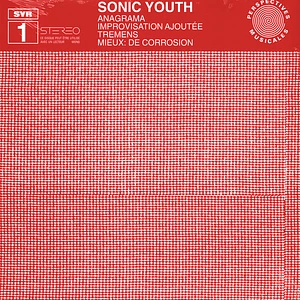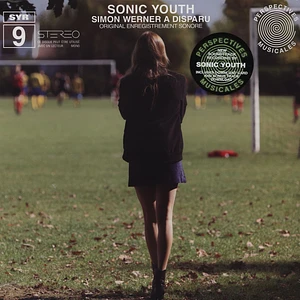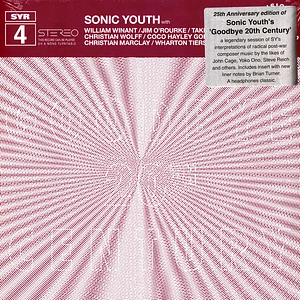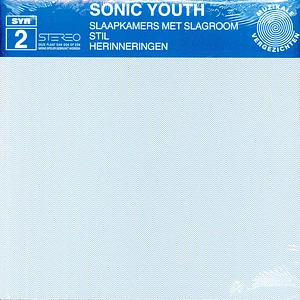The fractal rock of Sonic Youth has, needless to say, always been about the challenge of space: the space between notes, the close dissonance of guitar figures that created all new overtones in their proximity. Television’s Tom Verlaine and Richard Lloyd themselves hinted at such microtonal methodology in their heroic solos that blasted the roles of twin lead electric guitars into poetic, simmering collision wedding chaos and tranquility, masterfully disassembling the primal thud of the rock genre into a nebula of intricate interactions that complemented each others’ paths. At times, for example, Verlaine’s Bollywood guitar jones reared its head and pirouetted around Lloyd’s Keith Richards moves; both played extended solos generating something wholly new and cerebral, yet adding nods to the places from whence they originated.
Sonic Youth in turn also drew on this (especially with Television’s influence) adding their own input: Hendrix, The Beatles, punk trash, and quite prominently the din of Downtown as presented and templated by the avant-garde composers Glenn Branca and Rhys Chatham. These two captured a maximal bent on minimalism by souping up guitar armies to sound like passing subways, then daring to situate themselves in the Classical bin of record stores. For Sonic Youth, the fringe was always the feeding trough from which ideas fed over the course of their story. The brutalist gronk of Confusion Is Sex eventually steered into sublime song- smithery on Evol. They also fed on the spirit of other mavericks of the particular moment, dense prog moves disseminated on Daydream Nation, which chimed in at a time when Hüsker Dü and The Minutemen were also creating daring double albums. As major labeldom eventually gave SY’s sideways rock a spot in mall chain stores next to the grunge peers they informed, they nevertheless pushed themselves further into exploration. With the addition of Jim O’Rourke to their ranks in the late 90’s, their DGC career took a turn into the thicket of exploring denser, long compositions at times evidenced on A Thousand Leaves and New York City Ghosts & Flowers. Concurrently a series of SYR Perspectives Musical self-releases explored not only the combination of improvisation and composition the band had mined as far back as 1986 with their Made In USA soundtrack (and companion Spinhead sessions that were released later), but soaking in O’Rourke’s encyclopedic knowledge of masters of 20th Century classical music he emblemized both solo, with combos and his Gastr Del Sol duo with David Grubbs.
Around this time I had moved to NYC, working at Kim’s Video, a local video/music joint that had been previously been a beacon for road trips to hoover up Krautrock, Japanese psychedelia and anything I could get my hands on. Fellow clerks I worked with, already stoked on the sounds of Berio, Xenakis, Stockhausen, Tudor, Feldman et al treated a Gastr Del Sol in- store event we had with the aplomb of the Beatles themselves live in the shop’s aisles. Mr. Kim himself, unsure what to do with this giant 4-story space in St. Mark’s place, even suggested to a rather enigmatic buyer (who I once witnessed arriving on a unicycle) that one floor would be made up of all 20th Century music. I recall visiting the barren floor in construction mode and seeing the fellow had names of all these composers scrawled on the empty walls like some mad astrophysicist putting mathematic formulas up on a chalkboard. The floor eventually just stocked cellphones. But at the time, this concept of the marginal corners of classical music being revisited as the future of a more mainstream music aesthetic had been in my brain. Lou Reed had already made a pass in his ’70’s interviews explaining Metal Machine Music with references to this world (scribes speculating he was snowing everyone, his backstory proving he wasn’t). Tower’s annex opposite their 4th Street superstore had brimmed with closeout Wergo imprint Cage and Nancarrow box sets as well as 25 cent Smithsonian Folkways LPs and Columbia-Princeton Electronic LPs. An article by Conrad Conrad I spied in Forced Exposure had framed the greatness of all this material in a 20th Century primer that highlighted the fact that these releases were not only fantastic but cheap! It was a bit noteworthy also to recognize that much of this stuff had major label muscle back in the day (albeit the less emphasized departments of those labels), so when Sonic Youth started exploring it with SYR 1/2/3 as a balancing point to their major label stuff, being issued independently, it was an interesting paradox. Where does this kind of music actually exist in the world and for what audience? Conflicting arrows pointed.
The advent of 1999’s SYR 4 addition, the double Goodbye 20th Century release, was a very exciting thing, to see how our heroes were throwing themselves fully into their own interpretations of this relatively highbrow, and decidedly un-rock material. Were they going electronic? What was Steve Shelley gonna rock? So many questions. Interestingly, a famous audio interview with John Cage featured him going off the rails after hearing Glenn Branca live, in a total non-embrace of the wall of “fascistic” order of Branca’s guitar compositions, its sustained climaxes, versus what Cage felt was the lack of anarchy, individuality and chance he himself had pioneered. At one point Cage even opines it represents “a shepherd not taking care of the sheep, but a leader insisting people agree with him, giving them no freedom whatsoever”, adding “the only fresh air that comes is when the technology collapses. The amplifier broke.” How would Sonic Youth, who got a Hangin’ With MTV audience pumping fists to “Kool Thing” offer up this new direction to their own flock?
In all truth, they were certainly not dilettantes when it came to this music, despite their heavily informed Branca-related inception. They were already fearless in publicly marking the wide variety of information that they ingested into their freeform identity: I recall hearing both Gyorgi Ligeti and Black Sabbath taped snippets pumped into the PA during SY’s opening spot for Neil Young in 1991 while guitars were being swapped between songs. The band’s outreach to kindred spirits in addition to O’Rourke certainly helped guide the new project’s vision. William Winant, who co-produced this release alongside SY and O’Rourke, was a longtime associate of Kim Gordon’s from Cal Arts days and not only was known for performing Lou Harrison compositions on percussion but also spent time in jazz combos, and Oingo Boingo. Christian Marclay, a Swiss-born composer mostly based in New York, was heavily influenced by Cage and Fluxus while spotlighting the mentality of record collecting via mutant utilization of turntable cut-ups, even reconfiguring pieces of records as objects themselves into improvised works. Marclay also championed an extreme freeform cultural aesthetic, something that jived quite well with the Sonics. Also onboard for the sessions were Wharton Tiers (SY’s longtime studio engineer cohort), Japanese Fluxus pioneer Takehisa Kosugi (then music director for Merce Cunningham Dance Company, and still very active in the New York scene) and maverick 20th Century composer Christian Wolff (who joins in on two of his own pieces, “Edges” from 1969 and “Burdocks” from 1971).
As a listening experience, these intricate, detailed pieces flow like a river. Wolff’s “Edges” sprawls into a 16 minute, rich tapestry of space, tonal bursts, bowed percussion and Kim’s whispered intonations. No power chords, no walls of “Death Valley ’69” barrage that would send Cage diving under his covers, just a disembodied flow of sound purity where egos converge into almost indefinable blurts of the cosmos. All players become interactive, raising their heads and contributing their charted, fleeting moments, open to the individual player’s (and listener’s) interpretation. Wolff’s “Burdocks” especially brims in color: broken doorbell sounds, Marclay’s quick percussive swipe of a needle, simmering cosmic frogs in alien bogs, whirring tapes, stunted hisses, faded chimes and creaks.
Elsewhere, the punk physicality of SY rears its head (and without doubt this is punk music); a very young Coco Hayley Gordon Moore’s twelve second vocal exercise appropriates Yoko Ono’s “Voice Piece For Soprano”. Her squeals segue neatly into Steve Reich’s “Pendulum Music” where swinging mics pile up phases of fleeting feedback howl around speakers to natural chaotic conclusion as the swings subside (a concept Lee Ranaldo would revisit in his more recent pendulum-guitar live performances). George Macunias’s 1962 “Piano Piece #13 (Carpenter’s Piece)” allows Kim, Lee, Thurston, and Steve to simply take shifts hammering nails into a piano in accordance with Macunias’ score. “Six For New Time” is a 1999 piece especially created for SY by Pauline Oliveros, evoking industrial winds gurgling far in the distance perhaps from a listener’s vantage point in a tranquil field, chattering and hissing around quietly read text from Thurston, never threatening the overall wall of ambience and meditativeness in the forefront. Eventually it creeps into a skeletal strum-and-throb guitar conclusion that might have cribbed a note or two from the Dead C’s own bonkers double set Harsh 70’s Reality.
Other highlights include “+ -“, originally composed in 1987 by Takehisa Kosugi where a marimba sounds like it’s propped up in a subway tunnel while scraped cymbals circle round and round, eventually pulling your head into some kind of void. There are three Cage pieces reimagined (including two organically different takes on “Six” (1991)), a subtle Winant/Ranaldo duo on “Pièce Enfantine” originally penned by Nicolas Slonimsky in 1951, and a heady interpretation on James Tenney’s “Having Never Written A Note For Percussion” from 1971. Tenney, like Sonic Youth, wrapped his mind around minimalism (he was an early component in early Philip Glass works) with emphasis on both sound composition and conceptual art; his chop-up of “Blue Suede Shoes” could easily have been plunked onto Master Dik back in ‘87. This piece, however, evolved from sending short compositions via postcard, and while geared for a solo percussionist eventually swallows up all the players involved to a droning, up-the- chimney crescendo. The album closes with a blissful take on Cornelius Cardew’s 1967 “Treatise”.
The band and cohorts took it all to the stage as well. Live material debuted at a Bowery Ballroom gig in April of 1999, showcasing a number of selections from Goodbye 20th Century joined by O’Rourke, Winant, Kosugi, and Tiers. Attendees received a complete program with charts of the compositions included, the front page adorned by a rather unforgettable Jim Shaw drawing of his experience of an illness receding with fevered visions of a trumpet-tooting mouse appearing bedside in the image of Doc Severinsen. The Tenney piece was inserted into another local gig I witnessed in a giant food court (!) at the South Street Seaport a few months later (with openers the New York Art Quartet), but for the most part the material took a hiatus live while Sonic Youth supported NYC Ghosts and Flowers and had a stint opening for Pearl Jam. Those tours were punctuated by occasional improvisational sets, but a full return to Goodbye 20th Century live happened in June of 2001 over some select dates of their European run (Paris, Zurich, Gent, Amsterdam, Barcelona, London and Bologna). Intriguingly “She Is Not Alone” culled from SY’s very first EP reared its head mixed in with some of these shows, a fitting snapshot of the band at its very early minimal phase gelling nicely with these deconstructed classical works. The Paris gig at the Olympic Theater is documented on the Sonic Bandcamp page and well worth a listen, joined by Viennese electronic artists Christian Fennesz, Winant, and even first-wave SY drummer Richard Edson in parts.
While the Goodbye 20th Century title itself hits the mark as both a sendoff to the millenium and a nod to the fact this officially titled brand of classical music is indeed not ‘expiring’ due to the calendar, it also notes a brash declaration of Sonic Youth clearing the decks of what its continuum could be now that a new era was beginning. Would Cage approve? In the same Branca-themed interview he cites Margaret Mead, saying “now that we live longer than we did, there’s no reason we should continue doing the same thing all the time. We could change, more than we thought was proper.” He goes on to feel gloom for the 21st Century under Branca’s tutelage: “if we follow the example, I doubt we’d have such a century, because no intelligence is suggested, only power and energy. We would more quickly by those means end ourselves even in the 20th Century.” He also questioned the concepts of novelty for its own sake, and the non-value of popularity for the validity of musical ideas, admitting he himself struggled to find something new to attempt. For Goodbye 20th Century Sonic Youth made a strong case for abandoning the playbook, emphasizing openness, intelligence and interchangeability in place of power. The notion of a group diplomatically making music, open- ended, egoless and curious, while concurrently maintaining a place in the rock pantheon in following projects certainly argues an even more colorful template of existence than perhaps Cage could even imagine at the time. As for any kind of impact of this kind of music in the 21st century, one year later you had Radiohead talking up Xenakis around Kid A and countless modern electronic heads taking notes, but in reality the crossover was always there in the past. McCartney fanned out on AMM and Stockhausen, and it was evident in The White Album. Harry Partch’s spirit was in Iggy. Terry Riley’s in Townshend. Did it make it popular? Well no, so, one will guess Cage would remain happy there at least. His worries about the 21st Century, based on the hordes of interesting artists applying his theories to a wide variety of progressive genres regardless of commerciality or lack of, seem for naught.
- Brian Turner Summer 2024



